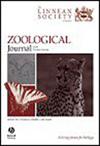Discovery of a new species of giant flying squirrel (Petaurista) from northwest Yunnan, China, sheds light on the origin and diversification of the genus
IF 2.8
2区 生物学
Q1 ZOOLOGY
引用次数: 0
Abstract
Petaurista is the largest and most taxonomically complex genus of extant flying squirrels and occurs in forests of Asia. Eight Petaurista specimens collected from both sides of the Nu (Salween) River in northwest Yunnan Province, China, did not match the diagnosis of any currently known species. We undertook a comprehensive morphological and genetic comparison between these specimens and other Petaurista species. Our results suggest that: (i) the northwest Yunnan specimens represent a new species that has been named Petaurista nujiangensis sp. nov.; (ii) magnificus, sybilla, and yunanensis and mishmiensis should be recognized as subspecies of Petaurista albiventer, Petaurista marica, and Petaurista nobilis, respectively; (iii) mechukaensis and muzongensis should be synonymized with Petaurista nobilis mishmiensis; (iv) there are 14 species within the genus Petaurista; and (v) Petauria is a distinct fossil genus, not related to Petaurista, and includes helleri and tetyukhensis. The estimated time of divergence and inferred ancestral distribution suggest that Petaurista originated in the Hengduan Mountains in the Miocene and underwent early diversification in situ. It subsequently spread to the Himalayas, Southeast Asia, and East Asia during the Late Miocene and Early Pliocene. Climate change and fluctuating sea levels during the Pliocene and Pleistocene then led to subspecies differentiation.中国云南西北部巨型鼯鼠(Petaurista)一新种的发现,揭示了该属的起源和多样化
飞鼠是现存飞鼠中最大、分类学最复杂的属,分布在亚洲的森林中。在中国云南省西北部怒温江两岸采集的8个Petaurista标本与目前已知的任何物种的诊断都不相符。我们将这些标本与其他Petaurista种进行了全面的形态和遗传比较。结果表明:(1)滇西北地区的标本为新种,命名为怒江佩陶里塔(Petaurista nujiangensis sp. 11 .);(ii)应分别将大花佩塔(magnificus)、sybilla和yunanensis和mishmiensis认定为albiventer、marica Petaurista和nobilis Petaurista的亚种;(iii) mechukaensis和muzonggensis应与Petaurista nobilis mishmiensis同义;(iv) Petaurista属有14种;Petauria是一个独特的化石属,与Petaurista没有亲缘关系,包括heleri和tetyukhensis。分离时间的估计和祖先分布的推断表明,Petaurista起源于中新世的横断山脉,并经历了早期的原位多样化。随后,它在中新世晚期和上新世早期传播到喜马拉雅山、东南亚和东亚。上新世和更新世期间的气候变化和海平面波动导致亚种分化。
本文章由计算机程序翻译,如有差异,请以英文原文为准。
求助全文
约1分钟内获得全文
求助全文
来源期刊
CiteScore
6.50
自引率
10.70%
发文量
116
审稿时长
6-12 weeks
期刊介绍:
The Zoological Journal of the Linnean Society publishes papers on systematic and evolutionary zoology and comparative, functional and other studies where relevant to these areas. Studies of extinct as well as living animals are included. Reviews are also published; these may be invited by the Editorial Board, but uninvited reviews may also be considered. The Zoological Journal also has a wide circulation amongst zoologists and although narrowly specialized papers are not excluded, potential authors should bear that readership in mind.

 求助内容:
求助内容: 应助结果提醒方式:
应助结果提醒方式:


